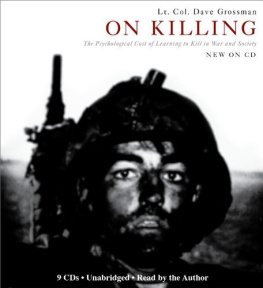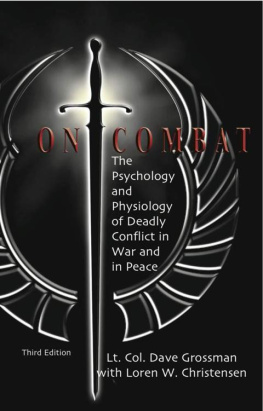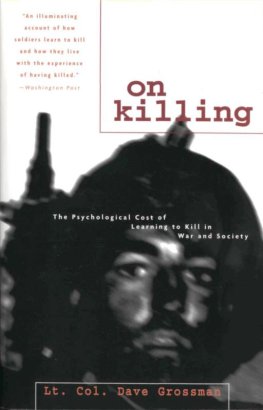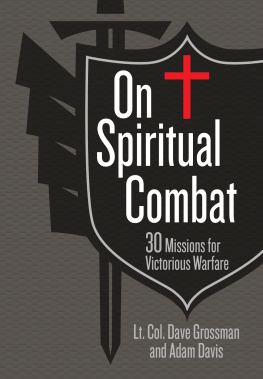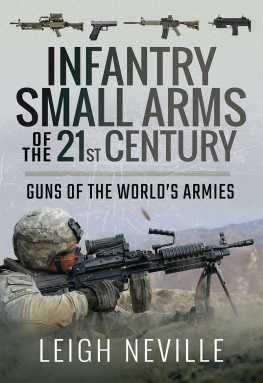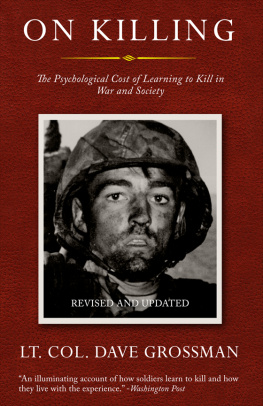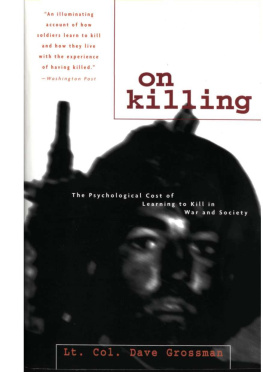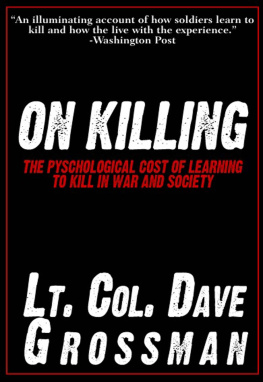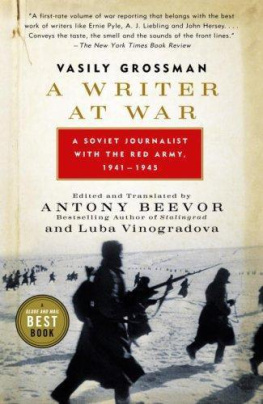

O N K I L L I N G
T h e P s y c h o l o g i c a l C o s t o f L e a r n i n g to Kill in War and S o c i e t y
by Lieutenant Colonel Dave Grossman
Back Bay Books
Little, Brown and Company
New York Boston
Copyright 1995,1996 by David A. Grossman
All rights reserved. No part of this book may be reproduced in any form or by any electronic or mechanical means, including information storage and retrieval systems, without permission in writing from the publisher, except by a reviewer who may quote brief passages in a review.
Back Bay Books / Little, Brown and Company
Time Warner Book Group
1271 Avenue of the Americas, N e w York, NY 10020
Visit our Web site at www.twbookmark.com
First Paperback Edition
Permissions to use previously published material appear on pages 352-53.
Library of Congress Cataloging-in-Publication Data Grossman, Dave.
On killing : the psychological cost of learning to kill in war and society / Dave Grossman. 1st ed.
p. cm.
Includes index.
ISBN 0-316-33000-0 (he) 0-316-33011 -6 (pb)
1. Combat Psychological aspects. 2. Psychology, Military.
3. Homicide Psychological aspects. 4. Violence Social aspects.
5. Violence Psychological aspects. I. Title.
U22.3.G76 1995
355V0019dc20 95-13888
Illustrations by Mary Reilly
20 19 18 17 16
Q - M B
Printed in the United States of America
Dedication
Not of the princes and prelates with periwigged charioteers Riding triumphantly laureled to lap the fat of the years, Rather the scorned the rejected the men hemmed in with spears; The men in tattered battalion which fights till it dies, Dazed with the dust of the batlle, the din and the cries, The men with the broken heads and the blood running into their eyes.
Not the be-medalled Commander, beloved of the throne, Riding cock-horse to parade when the bugles are blown, But the lads who carried the hill and cannot be known.
Others may sing of the wine and the wealth and the mirth, The portly presence of potentates goodly in girth;
Mine be the dirt and the dross, the dust and scum of the earth!
Theirs be the music, the colour, the glory, the gold; Mine be a handful of ashes, a mouthful of mould.
Of the maimed, of the halt and the blind in the rain and the cold
Of these shall my songs be fashioned, my tale be told. Amen.
John Masefield
"A Consecration"
Contents
Acknowledgments
IX
Introduction to the Paperback Edition
xiii
Introduction
xxiii
Section I Killing and the Existence of Resistance: A World of Virgins Studying Sex
Chapter One Fight or Flight, Posture or Submit, 5
Chapter Two Nonfirers Throughout History, 17
Chapter Three Why Can't Johnny Kill? 29
Chapter Four The Nature and Source of the Resistance, 37
Section II Killing and Combat Trauma: The Role of Killing in Psychiatric Casualties
Chapter One The Nature of Psychiatric Casualties: The Psychological Price of War, 43
Chapter Two The Reign of Fear, 51
Chapter Three The Weight of Exhaustion, 67
Chapter Four The Mud of Guilt and Horror, 74
Chapter Five The Wind of Hate, 76
Chapter Six The Well of Fortitude, 83
Chapter Seven The Burden of Killing, 87
Chapter Eight The Blind Men and the Elephant, 94
VI
C O N T E N T S
Section III Killing and Physical Distance: From a Distance, You Don't Look Anything Like
a Friend
Chapter One Distance: A Qualitative Distinction in Death, 99
Chapter Two Killing at Maximum and Long Range: Never a Need for Repentance or Regret, 107
Chapter Three Killing at Mid- and Hand-Grenade Range:
"You Can Never Be Sure It Was You," 111
Chapter Four Killing at Close Range: "I Knew That It Was up to Me, Personally, to Kill Him," 114
Chapter Five Killing at Edged-Weapons Range:
An "Intimate Brutality," 120
Chapter Six Killing at Hand-to-Hand-Combat Range, 131
Chapter Seven Killing at Sexual Range: "The Primal Aggression, the Release, and Orgasmic
Discharge," 134
Section IV An Anatomy of Killing:
All Factors Considered
Chapter One The Demands of Authority: Milgram and the Military, 141
Chapter Two Group Absolution: "The Individual Is Not a Killer, but the Group Is," 149
Chapter Three Emotional Distance: "To Me They Were Less than Animals," 156
Chapter Four The Nature of the Victim: Relevance and Payoff", 171
Chapter Five Aggressive Predisposition of the Killer: Avengers, Conditioning, and the 2 Percent
Who Like It, 177
Chapter Six All Factors Considered: The Mathematics of Death, 186
C O N T E N T S
VII
Section V Killing and Atrocities: "No Honor Here, No Virtue"
Chapter One The Full Spectrum of Atrocity, 195
Chapter Two The Dark Power of Atrocity, 203
Chapter Three The Entrapment of Atrocity, 214
Chapter Four A Case Study in Atrocity, 217
Chapter Five The Greatest Trap of All: To Live with That Which Thou Hath Wrought, 222
Section VI
The Killing Response Stages: What Does
It Feel Like to Kill?
Chapter One
The Killing Response Stages, 231
Chapter Two
Applications of the Model: Murder-Suicides,
Lost Elections, and Thoughts of Insanity, 241
Section VII Killing in Vietnam: What Have We Done to Our Soldiers?
Chapter One Desensitization and Conditioning in Vietnam: Overcoming the Resistance to Killing, 249
Chapter Two What Have We Done to Our Soldiers? The Rationalization of Killing and How It
Failed in Vietnam, 262
Chapter Three Post-Traumatic Stress Disorder and the Cost of Killing in Vietnam, 281
Chapter Four The Limits of Human Endurance and the Lessons of Vietnam, 290
Section VIII
Killing in America: What Are We Doing
to Our Children?
Chapter One
A Virus of Violence, 299
Chapter Two
Desensitization and Pavlov's Dog at the
Movies, 306
C O N T E N T S
viii
B. F. Skinner's Rats and Operant
Chapter Three
Conditioning at the Video Arcade, 312
Social Learning and Role Models in the
Chapter Four
Media, 317
The Resensitization of America, 323
Chapter Five
Notes
Bibliography
Index
Acknowledgments
War has always interested me; not war in the sense of maneuvers devised by great generals... but the reality of war, the actual killing. I was more interested to know in what way and under the influence of what feelings one soldier kills another than to know how the armies were arranged at Austerlitz and Borodino.
Leo Tolstoy
I have been assisted in this study by a host of great men and w o m e n w h o have stood beside me and gone before me in this endeavor.
These I do n o w gratefully acknowledge.
To my wonderful and infinitely patient wife, Jeanne, for her staunch support; to my mother, Sally Grossman; and to Duane Grossman, my father and co-conspirator, whose many hours of help in research and concept made this book possible.
To the Indian Battalion of Arkansas State University, the finest R O T C battalion in the U.S. Army. To my fellow soldier-scholars among the R O T C cadre, to all my dear friends among the staff and faculty at Arkansas State University, and particularly to Jan Camp, w h o helped much with preparing the final draft and getting quotation authorizations. And most of all to my young R O T C
Next page
